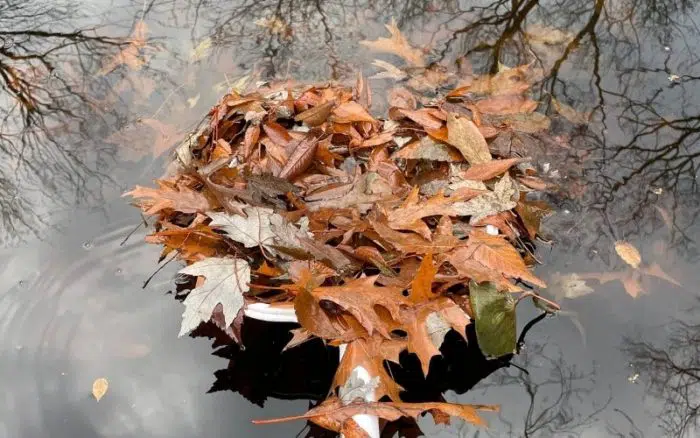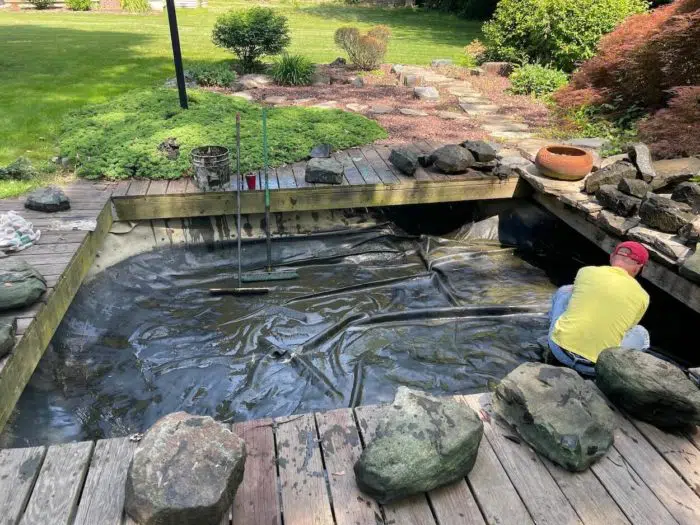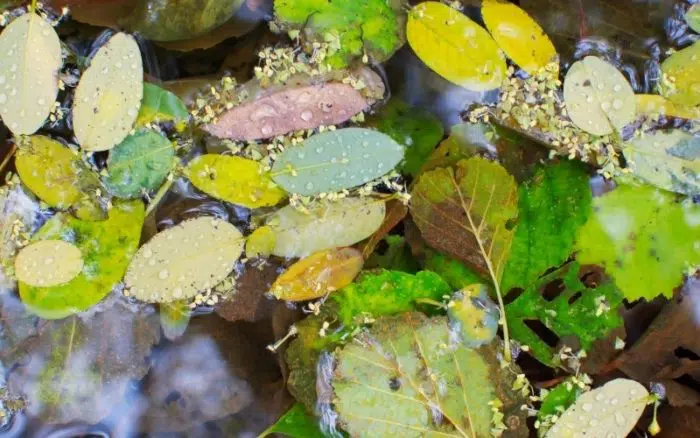Confession time: I let my pond get way too scummy and kind of neglected it over the winter. I didn’t even need to feed the fish because there was so much algae and bacteria for them to feed on. Sadly two of my finned friends didn’t make it through the winter because it froze over a few times.
I need to get this thing cleaned up, and give those survivor fish a better life – so I am sharing my strategy for that and how it goes. Consider this my DIY Before and After pond cleanup!
I’m calling this:
Operation: Clean Pond Without Killing the Fish
When it comes to ponds, there’s a lot of work that goes into keeping them clean. If you let the debris and algae build up like I did, your pond will quickly become a murky, bacteria-filled mess.
The current state of my pond water is brown and smells really bad. There are lots of decaying leaves, plants and it has a beautifully fishy smell. Ugh.

There are two ways you can clean a pond:
- Drain the entire pond, clean it, and refill it
- Don’t drain it, spend more time, but save the water
I’m going with option two, mainly because I fully cleaned this out last season to patch some holes, and I really don’t want to do that again.

It was muddy and gross, so I’m attempting this again without draining the pond. There are a few other reasons I don’t want to drain the pond completely:
- It messes with the pond’s ecosystem and gets rid of all good bacteria
- You can shock the fish with such a big change to the water
- If you refill with tap water, there could be too much chlorine
- Did I mention it’s a pain in the butt?
However, if you have any holes or leaks in the pond liner, you want to drain the pond so you can patch the holes up. Otherwise, you can run into problems with those leaks turning into full blown holes, and then you’ll need to drain the pond anyway, probably at a much less convenient time.
If you’re interested in my current setup, you can see that here.
How to Clean a Pond Without Draining the Water
Since we don’t want to drain the pond, we’re going to have to work with what we’ve got and use some additional tools.
What You Need
Aside from elbow grease, we’re going to need a few tools.
- A pond or pool skimmer
- Blue dye or algaecide for preventing future growth
- A large bucket or fish holding tank if you’re going to remove the fish
And lastly, get some good gloves and clothes you don’t care about getting muddy. Because this is going to be a dirty job.
1. Remove Leaves, Sticks and Other Plant Debris
One of the most important steps in cleaning your pond is removing any excess debris. Leaves, sticks, and other materials like dead plants, can quickly create a mess and make it difficult for you to see what’s going on underwater. Not to mention, all that garbage can be a breeding ground for algae and bacteria.

Of course, we want some beneficial bacteria, but we also want to be able to not be looking at brown water and smelling pond scum.
I had a bunch of floating plants that I didn’t bring inside in time and they died in the cold winter weather. Those, and the dead leaves that fell from the trees around the pond can cause serious clogs in the pond filter, so I need to get those out ASAP.
My method for doing this is just using a net or pool skimmer. It’s going to take quite a bit of time, but it needs to be done. Maybe I’ll remember this next fall when the leaves are falling and do a little at a time so I’m not in this mess again.
Once I skim off leaves, I’m putting them into my garden cart and hauling them to the compost pile. The algae and bacteria is probably going to be great for compost! Repeat until done.
If you have a pond vacuum, I’m jealous because you can get all the sludge off the bottom too and have clean water faster. I’m trying not to spend the money on one right now, so let’s try this without it.
2. Clean out the Pond Pump and Filter
My pond filter would clog immediately if I ran it with all the leaves in there, which is why this step comes second.
I have a Eco-Clear Submersible Pond Pump that should come out of the water pretty easy when I remove it.
You want to check your user manual to see if there are any tricky steps to properly taking the filter out of the pond.
The last pump we had was getting a little old and I yanked it the wrong way and it snapped the piece that fit into the hose. While that was a good excuse to get a better pump, if you like yours then try and be gentle with it. 🙂
Because of all the string algae last season, I’m thinking this pump need a full clean out, not just a rinse.
3. Reinstall Pond Filter
Once the pond pump and filters have been cleaned out, it’s time to put them back into place and start…those…engines!
Since I have a water feature with a spillway, I need to clean out those filter pads regularly as well.
So after the pump filter has been running for a few hours, I’m going to go ahead and checked the spillway mats again as they are probably going to get dirty pretty quick trying to clean out all of the pond scum we let build up.
4. Add Pond Dye to Prevent Algae Growth
Since we have fish in the pond, we need to make sure that this product doesn’t have chlorine or other chemicals that could harm the fish.
Last season, I had this new fun phenomenon called string algae. If you’ve never experienced this, it looks and act like string. It is super slippery, gets stuck in the pond pump and is challenging to skim out with a skimmer.
This season, I want to try and avoid that as much as possible, so I’m going to add some blue pond dye to help give the pond a nice color and reduce the growth of nasty algae blooms.
This stuff is apparently safe for fish and wildlife and even pond plants. And it also shouldn’t kill any of the beneficial bacteria in the pond either.
- Safe for humans, fish, and wildlife
- Shades pond to help discourage algae growth
My Current Backyard Pond Setup
I inherited this pond when we bought our property, but have made some upgrades since thanks to a family friend.
- XX gallon pond
- EPS3700 Eco-Clear Submersible Pond Pump – 3680 gph
- Spillway
- Spillway filtration mats
- Rock water feature
Pond Upgrades
There are a few upgrades I want to make to my pond to help it run even more efficiently, and prevent more green water down the line.
Installing an Aeration Pump
Aeration pumps help oxygenate the water and increase oxygen levels for the fish. There are even solar aeration pumps so you can have it running without using electricity, which is great.
They also help mix the water around and create movement. I am interested in this to help keep mosquitoes from settling and laying eggs on the surface. I’m one of those people who gets bit first, second, and last when outside during the summer. Since mosquitoes prefer still water to lay eggs, I want as much movement as possible.
This one gets awesome reviews and comes with 2 "outlets", which means I can have bubbles coming up in two places in the pond. There is a 4 outlet one, but I don't think my pond is large enough for that.
Since I have a spillway that drops water back into the pound at about 6 inches above the surface, I do have quite a bit of movement on the back side of the pond. But the front could use a little more movement.
This also should help during the winter to prevent a full freeze over of the pond. I had to melt holes into the surface to make sure the fish got enough oxygen, and this would hopefully help eliminate that next winter.
When is the Best Time to Clean a Pond?
I found that early spring is a great time to refresh and clean the pond. The water temperature is warming up and the fish are no longer in “winter mode” as I call it.
During the winter they slow down a LOT and loud noises can shock or even kill them. To avoid giving the fish a heart attack, it’s best to wait until they’re back to normal and can handle a lot of movement.
Cleaning out the pond in the early to mid spring helps you get ahead of algae growth that’s inevitably going to pick up speed during the warmer months.
Future Pond Maintenance
Now that my pond is back to clear, I’m going to have to make sure to keep up with the maintenance so I don’t have to repeat this process next spring.
This is the schedule I’m thinking of adopting, and I’ll have to come back here and adjust it as I learn what works for my pond.
- Adding mosquito dunks – weekly
- Add pond dye – biweekly
- Clean spillway filter mats – 2-3 times per week
- Skim out leaves and debris – weekly
Keeping backyard ponds clean can be quite the challenge if you neglect it for even a few weeks.




